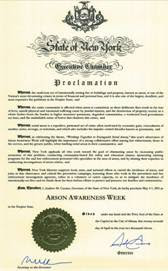
National Arson Awareness Week is traditionally observed the first week in May, and this year's theme is “Working Together to Extinguish Serial Arson.”
The goal of this year's Arson Awareness Week is to zero in on the horrific crime of arson, and to use the week of May 1st to the 7th to focus public attention on serial arsonists and provide law enforcement, fire and emergency service departments and communities with tools and tactics to prevent arson in their cities and towns.
This week being Nation Arson Awareness Week everyone should be aware of the growing problem of arson and it is urged that all should get involved in community efforts to combat this crime that threatens their safety and well-being. Prevention is the best way for all to be protected with ongoing efforts this week to raise citizen awareness of the arson problem and increase communi
ty involvement which will go a long way toward saving lives and property.
Communities can start with a neighborhood watch program to create heightened public awareness of the arson problem and to act as a deterrent to arson crimes by working with local fire, police and code enfor cement to recognize and report unusual activities. Arson can be reduced by having an involved and informed community working together with the fire service and law enforcement.
Here in New York State a call to action came as Governor Andrew M. Cuomo proclaimed Sunday, May 1, through Saturday, May 7, as Arson Awareness Week in New York State. A copy of that proclamation is below wit a link to the PDF file to view.

According to the U.S. Fire Administration's National Fire Incident Reporting System data, from 2004 to 2006 an estimated 210,300 intentionally set fires occurred each year in the United States. Intentionally set fires account for 13 percent of fires responded to by fire departments across the nation. These fires resulted in an average of approximately 375 deaths, 1,300 injuries and more than $1 billion in property loss each year.
Arson robs communities of its valuable assets — lives and property, Arson destroys more than buildings, it can devastate a community resulting in the decline of the neighborhood through increased insurance premiums, loss of business revenue, and a decrease in property values.”
Steps that can reduce incidents of arson include:
* Contact your local fire or police department if you know or suspect an arson crime.
* Report suspicious activity near houses or other buildings to your local fire or police department, or call 911.
* Support Neighbourhood Watch programs.
* Keep leaves and flammable debris away from buildings. Don't make it easy for an arsonist to start a fire or facilitate a fire's spread to adjacent buildings.
* If you see something, say something.
The Bureau of Alcohol, Tobacco, Firearms and Explosives (ATF) reports that from 2009 - 2010 there were 88 reported serial arson incidents with an aggregate monetary loss of $4.8 million. Arson in residential dwellings accounted for 49 percent of these incidents.
U.S. Fire Administration’s Arson Awareness Week web page www.usfa.fema.gov/aaw/ has information on neighborhood watch strategies, a new report on Motive-Based Offenders, Analysis of Serial Arsonists, joint fire and police teams and task forces, resources for fire investigators and information on witness-driven investigation protocols.
The United States Fire Administration recommends everyone should have a comprehensive fire protection plan that includes smoke alarms, residential sprinklers, and practicing a home fire escape plan.
(The usual disclaimers: I am not a journalist; This isa blog that expresses an outlook and is not conclusive in any shape or manner.)

